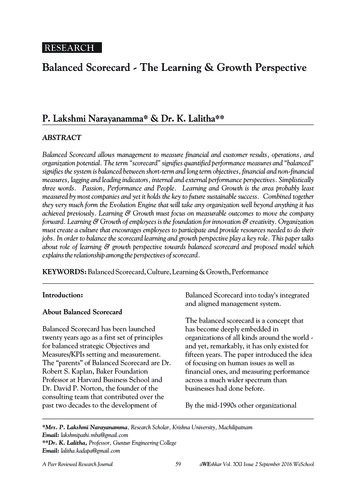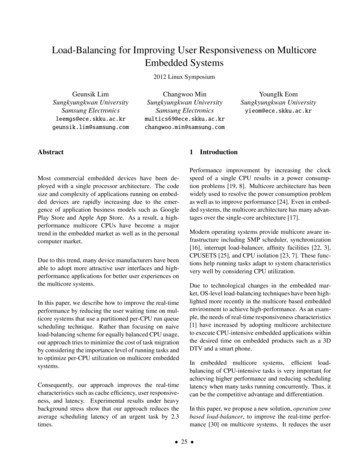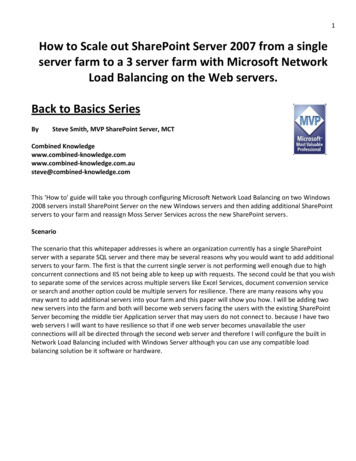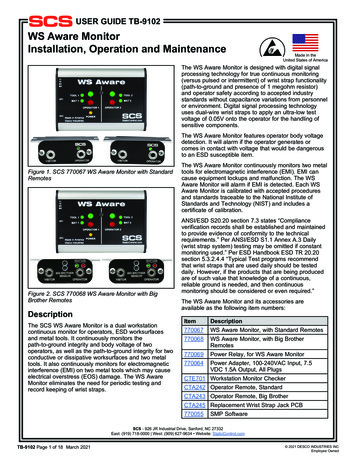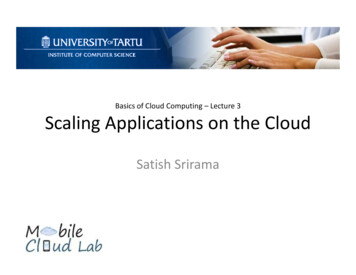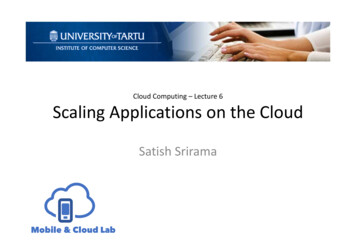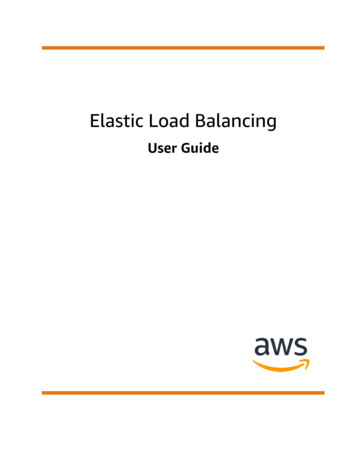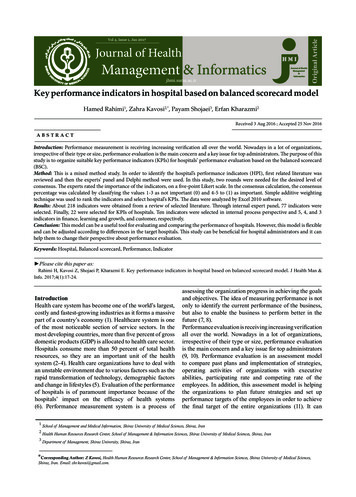
Transcription
(IJACSA) International Journal of Advanced Computer Science and Applications,Vol. 12, No. 10, 2021Load Balanced and Energy Aware Cloud ResourceScheduling Design for Executing Data-intensiveApplication in SDVCMs. Shalini. S1, Dr. Annapurna P Patil2Department of Computer Science and Engineering, ACM Engineering College, Bangalore, India1Department of Computer Science and Engineering, Ramaiah Institute of Technology, Bangalore, onsnumerous cloud-based Vehicular Adhoc Network (VANET)applications. For providing better bandwidth and connectivity indynamic manner, Software Defined VANET (SDVN) isdeveloped. Using SDVN, new VANET framework are modeled;for example, Software Defined Vehicular Cloud (SDVC). InSDVC, the vehicle enables virtualization technology throughSDVN and provides complex data-intensive workload executionin scalable and efficient manner. Vehicular Edge Computing(VEC) addresses various challenges of fifth generation (5G)workload applications performance and deadline requirement.VEC aid in reducing response time, delay with high reliability forworkload execution. Here the workload tasks are executed tonearby edge devices connected to Road Side Unit (RSU) withlimited computing capability. If the resources are not available inRSU, then the task execution is offloaded through SDN towardheterogeneous cloud server. Existing workload scheduling incloud environment are designed considering minimizing cost anddelay; however, very limited work has been done consideringenergy minimization for workload execution. This paper presentsa Load Balanced and Energy Aware Cloud Resource Scheduling(LBEACRS) design for heterogeneous cloud framework.Experiment outcome shows the LBEACRS achieves bettermakespan and energy efficiency performance when comparedwith standard cloud resource scheduling design.Keywords—Cloud computing; data-intensive applications;heterogenous server; IEEE 802.11p; software defined network;software defined vehicular cloud; vehicular adhoc network;workload scheduling; road side unit; vehicular edge cloudI.INTRODUCTIONAs of late, its seen that the amount of Internet associatedgadgets are more when compared with the quantity of peoplein the world, Internet-associated gadgets are expected toexceed thirty billion by 2020, as per report suggested in [1],thus, accidentally apprehending the IoT models. As there is anenormous increase in the vehicles which are connected to theinternet, the normal VANETs are merged into these Internet ofVehicles (IoV). In the Internet of Vehicles period, smartdevices and sensors are connected to the vehicles which cangive smart vehicle maneuvering, video streaming, preventionof accidents, traffic management, navigating capabilities, justas a large group of arising intelligent applications, aparticularly augmented and virtual reality. A vast majority ofthese applications require complicated computation andvarious methods to recognize the patterns, which can computeintensive data and thus need a processor which can provide apowerful and dedicated virtual machine for the computation.The restricted capability for the computation and the becauseof less resource’s capacity in the vehicles, it is a challengingtask for the decision-making, networking and data processingin real-time. Due to this problem, it develops an issue forcomputing the data and allocating the resources to the differentapplications in the VANETs which have limited resources.To resolve the problems of unstable computation in thevehicles, the usage of the vehicle nodes is suggested. For theimprovement of the safety and comfort for the travelers in acloud-based vehicle network a method using the Road SideUnits (RSUs) can be used. In the RSU, using the computingmethods and an integrated communication technology, variousoffload task can be done using the cloud, hence this reduces thepower consumption and the storage capacity in the OnboardUnit which is present in the vehicles. This method is called asMobile Cloud-Computing (MCC), which provides animproved utilization of the resource, better performance forcomputation and also gives many benefits, yet not restricted to,1) increasing the lifetime performance of the battery byoffloading the consumption of energy to the cloud, 2)empowering complex memory exploiting gadgets to portableclients, and 3) giving more memory-storage to the clients.Nonetheless, thinking about the limit constraint and fluctuationin the delay for transmitting the data to backbone and backhaulsystems [2], placing the cloud network far from the vehicularnetwork can reduce the efficiency of the offload. All the thingsconsidered, the vehicle edge computing (VEC) has been givenwhich places the cloud networks near the edge of the radioaccess organization, to be specific, near the Road Side Units,which gives the computation results within the range ofcommunication with the help of SDN.The concentrated idea of Vehicular Edge Computingpresents critical difficulties particularly in a profoundly uniquecondition like VANET. Besides, in vehicles having highmobility [3], [4], particularly in roads encountering moretraffic, requires an appropriate scheduling to prepare theoffloaded complicated workload assignments which can obligethe tasks which are delay tolerant (for example safety relatedapplication, accident prevention) just as computationallythorough assignments (for example video observation ommunication requests for quality of experience (QoE)and quality of services (QoS) to understand the related368 P a g ewww.ijacsa.thesai.org
(IJACSA) International Journal of Advanced Computer Science and Applications,Vol. 12, No. 10, 2021advantages like maximized throughput, low latency, fastcommunication, high reliability and hence forth Theseprerequisites makes workload resource scheduling more testingin vehicular cloud environment [5].In addressing above discussed research problem andchallenges existing workload scheduling methods eitherfocused on minimizing energy or makespan individually; andvery limited work have been emphasized in buildingscheduling optimization considering both together. However,existing model failed balance load for scheduling of newlyarrived task. As a result, induce scheduling delay and increasesoperation cost because of higher SLA violation. In addressingperformance issues the future design must incorporate effectiveload balancing technique with energy-makespan tradeoffrequirement as a major objective. This motivates the researchwork to develop an improved scheduling designingincorporating effective load-balancing technique namely loadbalanced energy aware cloud resource scheduling. TheLBEACRS design present an efficient design to schedulebacklog task with high resource utilization. Further, forselecting cloud resource to execute workload a tradeoffs metricof energy maximization with high resource utilization meetingtask deadline is presented.The manuscript significance is described below: This paper presents a load balanced and energy awarecloud resource scheduling method for executing dataintensive workload on software defined vehicular cloud(SDVC). The SDN is used to offload workload execution tocloud environment. It also maintains routing table fordelivering the workload execution outcome torespective vehicle users. The LBEACRS model is designed in such a way that itcan balance load among different server, maximizeresource utilization and reduce energy consumption byrunning less number of server and also guarantee deadrequirement of workload with high makespanefficiency. The LBEACRS reduce energy consumption andachieve better makespan performance in ology.The manuscript is articulated as follow. In Section II,survey of existing model and limitation is described. InSection III the present propose methodology for workloadscheduling in SDN enabled VANET-Cloud environment. InSection IV, experiment analysis is presented. Finally, theresearch work of LBEACRS is concluded with future researchdirection.II. LITERATURE SURVEYThis section carry out critical review of various workloadscheduling technique in reducing cost, makespan with deadlineconstraint; however, very limited work has been done tominimize energy constraint for workload execution inheterogeneous cloud environment [6]. In [6] presented energyaware scheduling strategy for executing workload and showedheterogeneous computing platform provide multiple processingcore for executing large-scale workload. However, thesestrategies induce high computation overhead and induce energyoverhead considering different levels of computational processand storage operations [7]. In [8], analysis on a super personalcomputer has been performed which has 16 thousand nodesutilizes more energy. The consumption of energy is a criticalproblem which has a huge impact in the computation of thedata and for the improvement of the system. In a heterogeneouscloud computing (HCC) condition, Directed Acyclic Graph(DAG) is used by an application which is running parallelly toallocate the jobs according to the priority. Moreover, theDirected Acyclic graph represents the edges and jobs whichportrays the messages correspondingly to the different jobs [9].In [10], it showed the critical difficulties exist for responsibilityplanning in a hybrid cloud environment. These are distinctiveCloud Service Providers (CSP), heterogeneous workload,which tell how to send and port the administration in the cloudenvironment having negligible financial spending plan. Forguaranteeing prevalent asset usage they introduced aheterogeneous workload planning for the remote cloudenvironment. Additionally, to guarantee the execution of theworkload, the execution is finished inside less time limitation aworkload planning component is introduced utilizing theBackhaul Propagation Neural-Network in the hybrid cloudframework. In [11], recommended that the work processscheduling configuration considers the financial spending planand time required for the computation in a hybrid cloudenvironment. The first scheduling-algorithm is plannedutilizing the single-objective which works specifically for theDCOH technique. This technique is planned to decrease themonetary spending plan of workload scheduling with cut-offtime essential. After this, they have introduced multi-objectiveon the basis of workload scheduled strategy to the specificMOH technique. This technique is intended to bring the tradeoffs among the financial spending plan and execution time forworkload execution. Notwithstanding, this technique is notmuch productive to reduce the energy for the logical workprocess computation in heterogenous cloud network. In Cloudnetwork, which provides service to the market, the clients aidthe cloud administrations given by CSP to perform theexecution of the workload. Workload for the most part includescertain cut-off time essential for guarantying QoS.Simultaneously, the poor performance of QoS can forceexacting a penalty on the CSP. Notwithstanding, the existingalgorithm for workload scheduling accepts the time for themakespan of the tasks in the data concentrated workloadapplication are fixed. In any case, this theory is for the cloudservers which have efficiently begun to help in theoptimization of the energy, which is not utilized in theworkload-scheduling model [11], [12].From extensive study it can be seen existing cloud resourcemanagement technique either focused on reducing energy ormakespan. Very few model presented to optimize time and costtogether employing multi-objective optimization. Further, thesemodel fails to meet dynamic load requirement of workloadapplication; thus, limit the adoption dynamic workloadapplication real-time requirement; in addressing an effective369 P a g ewww.ijacsa.thesai.org
(IJACSA) International Journal of Advanced Computer Science and Applications,Vol. 12, No. 10, 2021load balancing mechanism is needed which is presented in nextsection.III. LOAD BALANCED AND ENERGY AWARE CLOUDRESOURCE SCHEDULING DESIGN FOR TASK EXECUTION INSDN ENABLED VANET-CLOUD PLATFORMThis section presents load balanced energy aware cloudresource scheduling design for SDN enabled VANET-Cloud.First, we describe the system model for SDN enabled VANETCloud. Second, presents load balanced and energy aware cloudresource Scheduling workload execution in SDN enabledVANET-Cloud. The software architecture of the definedVANET-Cloud is shown in Fig. 1.A. System Model of SDN enabled VANET-CloudThis section present system model used for task schedulingin SDN enabled VANET-Cloud. Here the vehicle moves atvarying speed in particular direction and execute different kindof data intensive and scientific applications. Here the vehiclesare connected to RSU which are placed in fixed position. TheseRSU are connected to SDN controllers through which taskexecution process is outsourced to cloud computingenvironment. The work aimed at minimizing task executiontime with minimal energy consumption aiding better resourceutilization through better load balancing strategy. The cloudenvironment used in this work is heterogeneous in naturewhich has different energy consumption and processingcapability for executing different task.B. Load Balanced and Energy Aware Cloud ResourceScheduling Design for Workload Execution in SDNenabled VANET-CloudThis section present load balanced energy aware cloudresource scheduling (LBEACRS) method for workloadexecution in SDN enabled VNET-Cloud environment. Here theworkload task submitted by vehicle is submitted to near-byRSU. The RSU execute the workload if it has resourceavailable or it is offloaded to heterogeneous cloud serverconnected through SDN controller. The LBEACRS method isdesigned in a way that can optimally distribute the task withminimal consumption of energy and meeting task deadlineconstraint without overloading the particular server. As thiswork considers dispatching task to multi-server environmenthere a task backlog scheduling model is presented. A backlogscheduling model for a set ofmulti-server platformwith sizeand its processing speed isis modelled in this work. Let consider thatheterogeneous multi-server platformis composed ofsimilar servers with processing capability .Fig. 1. Architecture of Software Defined VANET-Cloud.Let consider a Poisson process withbacklogscheduling model considering sequence of tasks with incomingload . The incoming load is identical and independent innature which distributed exponentially randomlywithaverage ( ̅ ). The LBEACRS method divide these tasksequence into sub-sequences, in such way that thesubsequences with incoming load is transmitted to multi-serverplatform, where,. Amulti-server platformkeeps a buffer with unboundedcapability for waiting task when entire server is busy. Herethe tasks are executed in first come first basis consideringmulti-server platform with task execution are identical andindependent with exponential random parameterandaverage ̅ . The servers of multi-server platform possessidentical execution processing capability; thus, taskprocessing makespan on respective sever of multi-serverplatform is identical and independent with exponentialrandomness as follows.(1)with average̅̅(2)The average amount of task that can be completed byrespective server within (i.e., average workload executionrate) is obtained using following equation.(3)̅The server utilization (i.e., the mean percentage of time aserver will be busy) is obtained using following equation.̅̅(4)Letrepresent the probability thattask will beprocessed or in waiting in backlogging system consideringmulti-server platformand is obtained using followingequation.({)(5)370 P a g ewww.ijacsa.thesai.org
(IJACSA) International Journal of Advanced Computer Science and Applications,Vol. 12, No. 10, 2021where(( )())(6)The probability of freshly arrived workload task that mustbe waited i.e. (backlogged) in multi-server platform whenentire server inis busy is computed using followingequation.This work aimed at allocating ideal resource with minimalexecution time for executing workload task under multi-serverplatform with varying processing speed and powerconsumption. Let consider a number of multi-server cloudplatform with size of, with varying powerconsumption and processing capability for executing workloadwith requirement ̅ with task arrival rate , and establish loaddistributionin achieving high performanceefficiency is obtained by minimizing following equation.(15)(7)The mean amount of workload task that are being inexecution processes or waiting within multi-server platformis computed using following equation.̅ (16)where(17)(8)Similarly, the mean workload task response makespan ofmulti-server platform is computed using following equation.̅̅()̅̅ (())(9)For simplicity the mean workload task response makespanof multi-server platformis computed using followingequation.̅The above equation is subject to following constraint(())(10)The energy consumed for executing task is obtained usingfollowing equation.wheredefines the task activity features,definesvoltage,represent load capacitane, anddefines clockfrequency, defines processor execution speed. The parameteris computed using following equation.(11)whereparameterand are some constant greater than . Theis computed using following equation.(12)This work consider heterogeneous multi-server platform;thus, the value of and is different for different server. Herewe consider two different energy mode such as idle and activemode. In idle mode, the machine dost execute any workloadtask and energy consumed is obtained using followingequation.()̅(13)Similarly, in active mode the server is running and waitingfor incoming workload task and energy consumed is obtainedusing following equation.()(14)and. Here the workload task arescheduled by minimizing Eq. (15) and meeting constraintdefined in Eq. (16) and (17) in order to achieves high resourceutilization and performance efficiency with minimal energydissipation.IV. SIMULATION ANALYSIS AND RESULTSHere experiment is conducted for evaluating LBEACRSalgorithm methodology over standard cloud resourcescheduling algorithm [11], [12]. Energy efficiency andmakespan are performance metrics used for validatingperformance. For carrying out experiment SIMITS simulator[13] is used. Further, for incorporating software definedvehicular cloud architecture CloudSimSDN [14] which is anextension of CloudSim simulator which is incorporated intoSIMITS. Further for providing secure communication amongcommunicating device such as vehicle, RSU, and SDNcontroller the message in SDN enabled vehicular adhocnetwork are encrypted using elliptical curve cryptography.Further, this assumes that each device is composed of tamperproof device obtained from trust authority for carrying outauthentication and pseudo-identity-based data signing thatassures anonymity of data owner and secure communication.For evaluating performance experiment is conducted byconsidering dynamic radio propagation model where vehiclewill move from urban-to-rural-to-highway and vice versa.Experiment is conducted considering two workload such asMontage and CyberShake workload [15]. The Montage andCyberShake workflow have been used for experiment. TheMontage workflow requires high I/O resource; however, theCyberShake requires CPU and memory resource. Thesimulation parameter considers for carrying out experiment aredescribed Table I.Fig. 2 shows the graphical representation of how themontage workflow is stored. Similarly in Fig. 3 the graphicalrepresentation of the CyberShake workflow has beenrepresented.A. Makespan Performance EvaluationHere makespan performance is evaluated for both proposedLBEACRS and existing DCOH workload schedulingmethodology. Two different workloads such as Montage and371 P a g ewww.ijacsa.thesai.org
(IJACSA) International Journal of Advanced Computer Science and Applications,Vol. 12, No. 10, 2021CyberShake is considered for evaluation. First experiment isconducted using Montage workload where the job size isvaried and makespan induced for executing workload usingDCOH and LBEACRS is graphically shown in Fig. 4. TheLBEACRS improves makespan performance by 66.955%,81.48%, 86.14%, and 89.83% over DCOH when job size is 25,50, 100, and 1000, respectively. An average makespanperformance enhancement of 81.1% is achieved usingLBEACRS over DCOH for executing Montage workload.SIMULATION PARAMETERS CONSIDEREDNetwork ParameterValueSDN enabled vehicular Adhocnetwork Size50km * 50kmNumber of Vehicles40Number of RSU1 per regionModulation schemeQAM-64Mobility of devices3 cycle per frameSDN enabled vehicular Adhocnetwork coding rateSDN enabled vehicular Adhocnetwork bandwidthSDN enabled vehicular Adhocnetwork data channel sizeSDN enabled vehicular Adhocnetwork control channel sizeNumber of SDN switches per RSUFig. 3. A Sample Graphical Representation of CyberShake Workflow.Montage workload execution makespan 000Makespan (s)TABLE I.0.7527 RS57.7271.77113.31873.821Fig. 4. Makespan Performance for Executing Montage Workload withdifferent Workload Size.1SDN enabled vehicular Adhocnetwork time slot sizeMessage information size27 bytesRadio propagation mobility modelDynamic environment such as urban,rural, and highwayMAC usedENCCMA, TECA & ERSResource scheduling usedLBEACRS & DCOHWorkload usedMontage & CyberShakeSimilarly, experiment is conducted using CyberShakeworkload where the job size is varied and makespan inducedfor executing using DCOH and LBEACRS is graphicallyshown in Fig. 5. The LBEACRS improves makespanperformance by 69.95%, 82.14%, 89.23%, and 92.29% overDCOH when job size is 30, 50, 100, and 1000, respectively.An average makespan performance enhancement of 83.4% isachieved using LBEACRS over DCOH for executingCyberShake workload.CyberShake workload excution makespanperformanceMakespan 0000Fig. 2. A Sample Graphical Representation of Montage 21.45LBEACRS1343.991418.981531.0811859.29Fig. 5. Makespan Performance for Executing CyberShake Workload withdifferent Workload Size.372 P a g ewww.ijacsa.thesai.org
(IJACSA) International Journal of Advanced Computer Science and Applications,Vol. 12, No. 10, 2021Similarly, experiment is conducted using CyberShakeworkload where the job size is varied and total energy inducedfor executing workload using DCOH and LBEACRS isgraphically shown in Fig. 7. The LBEACRS improves energyefficiency performance by 75.17%, 95.30%, 96.12%, and93.63% over DCOH when job size is 30, 50, 100, and 1000,respectively. An average total energy consumption reduction of90.057% is achieved using LBEACRS over DCOH forexecuting CyberShake workload. Further, the average energyincurred for executing each sub-task using DCOH andLBEACRS is graphically shown in Fig. 9. The LBEACRSimproves average energy induced per task performance by41.35% over DCOH for executing CyberShake workload.CyberShake workload execution total energyconsumption performance350000000Power Sum 0000000DCOHFig. 7. Energy Consumption for CyberShake Workload Execution withdifferent Workload Size.Montage workload execution average energyconsumption performance35302520151050Montage workload total energy 56218228.65567714 28.655701 28.6557204LBEACRS 00Fig. 8. Average Energy Consumption for Montage Workload Executionwith different Workload Size.2000000015000000CyberShake workload execution average energyconsumption 501001000500514.374 1110499.19 2342175.63 24619249LBEACRS 126978.333 157883.182 249275.558 1922348.06Fig. 6. Energy Consumption for Montage Workload Execution withdifferent Workload Size.Power Consumption (W)Energy consumed (W)305010010008560738.28 48076391.9 105125808 294508805LBEACRS 2125544.53 2257788.76 4076664.24 18753715.4Energy consumed (W)B. Energy Consumption Performance EvaluationHere energy performance is evaluated for both proposedLBEACRS and existing DCOH workload schedulingmethodology. Two different workloads such as Montage andCyberShake is considered for evaluation. First experiment isconducted using Montage workload where the job size isvaried and total energy induced for executing workload usingDCOH and LBEACRS is graphically shown in Fig. 6. TheLBEACRS improves energy efficiency performance by 74.63,85.78%, 89.36%, and 92.19% over DCOH when job size is 25,50, 100, and 1000, respectively. An average total energyconsumption reduction of 85.49% is achieved usingLBEACRS over DCOH for executing Montage workload.Further, the average energy incurred for executing each subtask using DCOH and LBEACRS is graphically shown in Fig.8. The LBEACRS improves average energy induced per taskperformance by 23.229% over DCOH for executing 10268.7963216968.79632245LBEACRS 40.3447792 40.3447796840.34478029 40.3447905Fig. 9. Average Energy Consumption for CyberShake Workload Executionwith different Workload Size.373 P a g ewww.ijacsa.thesai.org
(IJACSA) International Journal of Advanced Computer Science and Applications,Vol. 12, No. 10, 2021From overall result attained it can be stated LBEACRS isscalable with respect to varying workload size and works wellfor both small and larger workload. And also shows they areefficient in provisioning CPU, memory and I/O intensive task.V. CONCLUSION[2][3][4]This work studies the challenges involved in workloadscheduling of data-intensive application on SDN enabledVANET-Cloud environment. From study we noted most ofexisting workload scheduling are done by predominantlyconsidering minimizing makespan and also minimizing costwith deadline constraint. Further, doesn’t balance load amongprocessing node. In standard the cost in generally computedbased on time spent. However, reducing energy plays majorrole as different countries has different prices. Thus, here aload balanced energy aware cloud resource scheduling ispresented. Here the tasks are scheduled to node that consumesless energy with better resource utilization. Experiments areconducted using two workloads, namely Montage andCyberShake. These workloads are CPU, I/O, and memoryintensive in nature. An average makespan performanceenhancement of 81.1% and 83.4% is achieved usingLBEACRS over DCOH for executing Montage andCyberShake workload, respectively. An average total energyconsumption reduction of 85.49% and 90.057% is achievedusing LBEACRS over DCOH for executing Montage andCyberShake workload, respectively. The LBEACRS improvesaverage energy induced per task performance by 23.229% and41.35% over DCOH for executing Montage and CyberShakeworkload, respectively. From overall result we can state thatthe LBEACRS is scalable irrespective of workload complexityand is robust with respect to CPU, I/O and memory 3]Future work would consider introducing SLA with qualityof experience guarantee in proving resource to VANET users.Further, incorporate effective security mechanism that canreduce key management, storage, and computation overhead.[1]REFERENCESK. Chopra, K. Gupta and A. Lambora, "Future Internet: The Internet ofThings-A Literature Review," 2019 International Conference onMachine Learning, Big Data, Cloud and Parallel MITCon.2019.8862269.[14][15]N. Abbas, Y. Zhang, A. Taherkordi and T. Skeie, "Mobile EdgeComputing: A Survey," in IEEE Internet of Things Journal, vol. 5, no. 1,pp. 450-465, Feb. 2018, doi: 10.1109/JIOT.2017.2750180.R. Hussain and S. Zeadally, Autonomous cars: Research results,issues, and future challenges,'' IEEE Commun. Surveys Tuts., vol. 21,no. 2, pp. 12751313, 2nd Quart., 2019.R. Lu, L. Zhang, J. Ni and Y. Fang, "5G Vehicle-to-EverythingServices: Gearing Up for Security and Privacy," in Proceedings of theIEEE, vol. 108, no. 2, pp. 373-389, Feb. 2020, doi:10.1109/JPROC.2019.2948302.I. Din, B.-S. Kim, S. Hassan, M. Guizani, M. Atiquzzaman, and J.Rodrigues, Information-centric network-based vehicular communications: Overview and research opportunities,'' Sensors, vol. 18, no. 11, p.3957, Nov. 2018.G. Xie, G. Zeng, R. Li and K. Li, "Energy-Aware Processor MergingAlgorithms for Deadline Constrained Parallel Applications inHeterogeneous Cloud Computing," in IEEE Transactions on SustainableComputing, vol. 2, no. 2, pp. 62-75, 1 April-June 2017.Z. Li, J. Ge, H. Hu, W. Song, H. Hu and B. Luo, "Cost and EnergyAware Scheduling Algorithm for Scientific Workflows with DeadlineConstraint in Clouds," in IEEE Transactions on Services Computing,vol. 11, no. 4, pp. 713-726, 1 July-Aug. 2018.K. Li, “Power and performance management for parallel computationsin clouds and data centers,” J. Comput. Syst. Sci., vol. 82, no. 2, pp.174–190, Mar. 2016.G. Xie, L. Liu, L. Yang, and R. Li, “Scheduling trade-off of dynamicmultiple parallel workflows on heterogeneous distributed computingsystems,” Concurrency Comput.-Parctice Exp., vol. 29, no. 8, pp. 1–18,Jan. 2017.Chunlin, L., Jianhang, T. & Youlong, L., “Hybrid Cloud AdaptiveScheduling Strategy for Heterogeneous Workloads”, J Grid Computing(2019) 17: 419. https://doi.org/10.1007/s10723-019-09481-3.Junlong Zhou et al., Cost and makespan-aware workflow scheduling inhybrid clouds. https://doi.org/10.1016/j.sysarc.2019.08.004, 2019.Neelima, P., Reddy, A.R.M. An efficient load balancing system usingadaptive dragonfly algorithm in cloud computing. Cluster Comput 23,2891–2899, 2020.Mario Manzano, Felipe Espinosa; Ning Lu; Xuemin Shen; Mark, J.W.;Fuqiang Liu, " Cognitive Self-Scheduled Mechanism for Access Controlin Noisy Vehic
challenges existing workload scheduling methods either focused on minimizing energy or makespan individually; and very limited work have been emphasized in building scheduling optimization considering both together. However, existing model failed balance load for scheduling of newly arrived task.
